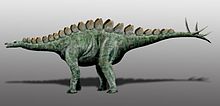Miragaia (dinosaur)
| Miragaia | ||||||||||||
|---|---|---|---|---|---|---|---|---|---|---|---|---|

Miragaia longicollum |
||||||||||||
| Temporal occurrence | ||||||||||||
| Upper Jurassic (late Kimmeridgian to early Tithonian ) | ||||||||||||
| 154.7 to 147.7 million years | ||||||||||||
| Locations | ||||||||||||
| Systematics | ||||||||||||
|
||||||||||||
| Scientific name | ||||||||||||
| Miragaia | ||||||||||||
| Mateus et al., 2009 |
Miragaia was a genus of dinosaurs from the stegosauria group . The holotype was found near Miragaia (Lourinhã) in Portugal and described in 2009. The only species is Miragaia longicollum .
The genus was named after the place where it was found; the specific epithet longicollum ( Latin : longus = long, collum = neck) was given because of its neck, which is extraordinarily long for stegosaurs.
Fossil documentation
The holotype consists of the almost completely preserved front half of the skeleton with a few skull fragments. A total of 15 cervical vertebrae have been preserved. The first and second cervical vertebrae ( Atlas and Axis) are missing . In addition, cervical ribs, two trunk vertebrae, both coracoids , the shoulder blade , the forelegs, twelve rib fragments , a chevron bone , a spine and 13 bone plates have been preserved in fossil form.
Fossil fragments of another juvenile specimen were also found at the site , including parts of the basin . Although none of the autapomorphies of Miragaia are detectable, the authors of the first description consider the fossil as belonging to Miragaia , but decided not to include it in the first description.
features
Miragaia longicollum was about six meters long. The species had a long neck that had 17 vertebrae, eight more than that of basal pelvic dinosaurs such as Scutellosaurus and more than most sauropods . As with Stegosaurus , the back was lined with vertical bone plates, which were much smaller and not pointed at the top, but rounded.
Systematics
The authors of the first description put Miragaia together with the second European stegosaur Dacentrurus in a new subfamily, the Dacentrurinae, which is said to be the sister group of Stegosaurus . This view contradicts the traditional view that Dacentrurus should be a basal stegosaur.
literature
- Octávio Mateus, Susannah CR Maidment, Nicolai A. Christiansen (): A new long-necked 'sauropod-mimic' stegosaur and the evolution of the plated dinosaurs. In: Proceedings of the Royal Society. Series B: Biological Sciences. Vol. 276, No. 1663, 2009, ISSN 0080-4649 , pp. 1815-1821, doi : 10.1098 / rspb.2008.1909 .
Individual evidence
- ^ Gregory S. Paul : The Princeton Field Guide To Dinosaurs. Princeton University Press, Princeton NJ et al. 2010, ISBN 978-0-691-13720-9 , pp. 223-224, online .
